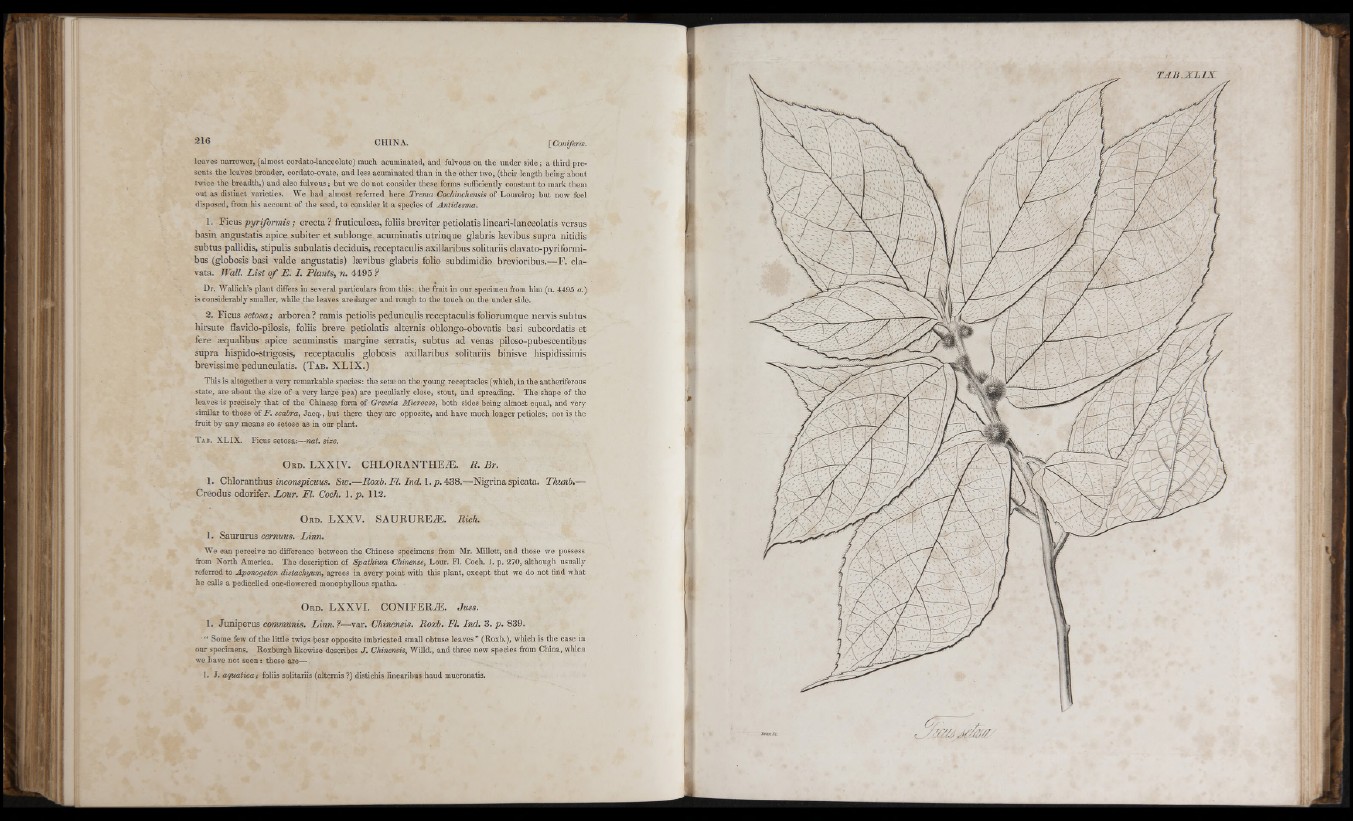
leaves narrower, (almost cordato-lanceolatc) much acuminated, and fulvous on the under side ; a third presents
the leaves broader, cordato-ovatc, and less acuminated than in the other two, (tlioir length being about
twice the breadth,) and also fulvous; but we do not consider these forms sufficiently constant to mark them
out as distmct varieties. We had almost referred here Trema Cochinchensis of Loureiro; but now feel
disposed, from his account of the seed, to consider it a species of Antidesma.
1. Ficus p y r ifo rm is; erecta ? fruticulosa, foliis breviter petiolatis lineari-lanceolatis versus
basin angustatis apice subiter et sublonge acuminatis utrinque glabris lævibus supra nitidis
subtus pallidis, stipulis subulatis deciduis, receptaculis axillaribus solitariis clavato-pyriformi-
bus (globosis basi valde angustatis) lævibus glabris folio subdimidio brevioribus.— F. cla-
vata. Wall. L is t o f E . 1. Plants, n. 4495 ?
Dr. Wallich’s plant differs in several particulars from this: the fruit in our specimen from him (n. 4495 a.)
is considerably smaller, while the leaves areJarger and rough to the touch on the under side.
2. Ficus setosa; arbóre a? ramis petiolis pedunculis receptaculis foliorumque nervis subtus
hirsute ilavido-pilosis, foliis breve petiolatis alternis oblongo-obovatis basi subcordatis et
fere ajqualibus apice acuminatis margine serratis, subtus ad venas piloso-pubescentibus
supra hispido-strigosis, receptaculis globosis axillaribus solitariis binisve hispidissimis
brevissime pedunculatis. (T ab. X L IX .)
This is altogether a very remarkable species: the setae on the yoimg receptacles (which, in the antheriferous
state, are about the size of a very large pea) are peculiarly close, stout, and spreading. The shape of the
leaves is precisely th at of the Chinese form of Grewia Microcos, both sides being almost equal, and very
similar to those of F. scabra, Jacq., but there they are opposite, and have much longer petioles; nor is the
fruit by any means so setose as in our plant.
T a b . XLIX. Ficus setosa:— nat. size.
O r d . L X X IV . C H L O R A N T H E Æ . R . B r.
1. Chloranthus ¿ncoraspfcMtts. Sw.—Roxb. Fl. Ind. \ . p . 43%.— Nigrina spicata. Thunb.—
Creodus odorifer. I¿our. Fl. Coch. l . p . 112.
O rd. L X X V . S A U R U R E Æ . Rich.
]. Saururus cernuus. L in n .
We can perceive no difference between the Chinese specimens from Mr. Millett, and those we possess
from North America. The description of Spathium Chinense, Lour. Fl. Coch. 1. p. 270, although usually
referred to Aponogeton distachyum, agrees in every point with this plant, except that we do not find what
he calls a pedicelled one-flowered monophyllous spatha.
O r d . L X X V I . C O N IF E R Æ . Juss.
1. Juníperos communis. L in n .?—var. Chinensis. Roxb. Fl. Ind. 3. p. 839.
• “ Some few of the little twigs bear opposite imbricated small obtuse leaves ” (Roxb.), which is the case in
our specimens. Roxburgh likewise describes J . Chinensis, Willd., and three new species from China, whicn
we have not seen : these are—
1. J . aquatica; foliis solitariis (alternis ?) distichis linearibus haud mucronatis.
I
I
i l